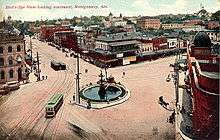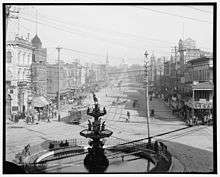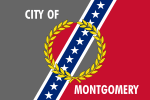Capital City Street Railway
The Capital City Street Railway, also known as the Lightning Route, was the first citywide system of streetcars established in Montgomery, Alabama, on April 15, 1886.[2] This early technology was developed by the Belgian-American inventor Charles Joseph Van Depoele. James Gaboury was the owner of the horse-drawn system that was converted to electricity. One trolley route ended at the Cloverdale neighborhood. This early public transportation system made Montgomery one of the first cities to "depopulate" its residential areas at the city center through transportation-facilitated suburban development. The system operated for exactly 50 years, until April 15, 1936, when it was retired in a big ceremony and replaced by buses.
 A view of three Lightning Route streetcars on a postcard from 1900–1920 | |
| Operation | |
|---|---|
| Began operation | April 15, 1886 |
| Ended operation | April 15, 1936 |
| Operation | |
|---|---|
| Began operation | 1890s[1] |

Racial segregation

It was on this system that Montgomery's segregated racial seating was established in the early 1900s, which continued on the city buses after 1936. There was a Montgomery streetcar boycott from 1900 to 1902 to protest segregated service.[3] However, the city council passed the Montgomery Streetcar Act in 1906 that further mandated a continuation of segregation.[4] Segregation ended with the famous Montgomery bus boycott started by Rosa Parks and led by Rev. Martin Luther King Jr. and E. D. Nixon that lasted from December 2, 1955, to December 20, 1956.
City ownership
In 1974, the City of Montgomery took over ownership of the system that was then known at the Montgomery Area Transit System or MATS.[5] Since the centennial of the Lightning Route in 1986 there have been various initiatives to re-establish a light-rail system in Montgomery. In place of light rail a system of tourist trolleys (diesel buses) known as the Lightning Route Trolleys currently operates in the city's historic districts.[1][5]
See also
- Berlin Straßenbahn - a Berlin electric streetcar system that started operation in 1881.
- Browder v. Gayle
- History of trams
- Richmond Union Passenger Railway - a Richmond, Virginia electric streetcar system that started operation in 1888.
- Union Station (Montgomery) - a preserved Lightning Route streetcar is housed in a building near the old railroad station.[6]
References
- "Montgomery Area Transit System". Archived from the original on 19 November 2008. Retrieved 14 December 2008.
- The Alabama Department of Archives and History page mentions streetcar development in 1886 at "Oak Park Montgomery’s First Public Park" and "Smith-Joseph-Stratton House" at "ADAH: Montgomery Historical Markers". Archived from the original on 14 July 2014. Retrieved 14 December 2008.
- Elsa Barkley Brown. "Women and the Civil Rights Movement". Archived from the original on 21 February 2007. Retrieved 14 December 2008.
- "Central Alabama Fair Housing Center". Archived from the original on 5 July 2008. Retrieved 14 December 2008.
- "History". Montgomery Area Transit System. Archived from the original on 4 December 2008. Retrieved 14 December 2008.
- "Montgomery Transportation". Retrieved 14 December 2008.
